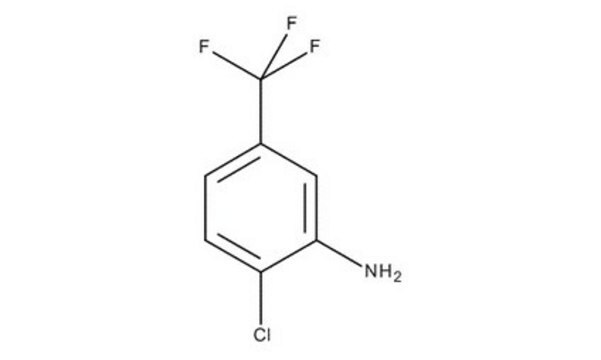All Photos(1)
About This Item
Empirical Formula (Hill Notation):
C8H8O4
CAS Number:
Molecular Weight:
168.15
MDL number:
UNSPSC Code:
12352100
PubChem Substance ID:
Recommended Products
Assay
97%
form
solid
mp
155-157 °C (lit.)
SMILES string
COC1=CC(=O)C=C(CO)C1=O
InChI
1S/C8H8O4/c1-12-7-3-6(10)2-5(4-9)8(7)11/h2-3,9H,4H2,1H3
InChI key
PXEBZHWTQGYVCO-UHFFFAOYSA-N
General description
2-Hydroxymethyl-6-methoxy-1,4-benzoquinone is known to enhance electron transfer processes such as ascorbate oxidation and NO reduction.
Application
2-Hydroxymethyl-6-methoxy-1,4-benzoquinone was employed as electron acceptor to investigate the pH dependence of the activity of pyranose dehydrogenase from Agaricus xanthoderma.
Signal Word
Warning
Hazard Statements
Precautionary Statements
Hazard Classifications
Eye Irrit. 2 - Skin Irrit. 2 - STOT SE 3
Target Organs
Respiratory system
Storage Class Code
13 - Non Combustible Solids
WGK
WGK 3
Flash Point(F)
Not applicable
Flash Point(C)
Not applicable
Personal Protective Equipment
dust mask type N95 (US), Eyeshields, Gloves
Certificates of Analysis (COA)
Search for Certificates of Analysis (COA) by entering the products Lot/Batch Number. Lot and Batch Numbers can be found on a product’s label following the words ‘Lot’ or ‘Batch’.
Already Own This Product?
Find documentation for the products that you have recently purchased in the Document Library.
Pedro Sanchez-Cruz et al.
Free radical biology & medicine, 49(9), 1387-1394 (2010-08-10)
Quinones are one of the largest classes of antitumor agents approved for clinical use, and several antitumor quinones are in various stages of clinical and preclinical development. Many of these are metabolites of, or are, environmental toxins. Because of their
Properties of pyranose dehydrogenase purified from the litter-degrading fungus Agaricus xanthoderma.
Magdalena Kujawa et al.
The FEBS journal, 274(3), 879-894 (2007-01-18)
We purified an extracellular pyranose dehydrogenase (PDH) from the basidiomycete fungus Agaricus xanthoderma using ammonium sulfate fractionation and ion-exchange and hydrophobic interaction chromatography. The native enzyme is a monomeric glycoprotein (5% carbohydrate) containing a covalently bound FAD as its prosthetic
Our team of scientists has experience in all areas of research including Life Science, Material Science, Chemical Synthesis, Chromatography, Analytical and many others.
Contact Technical Service









